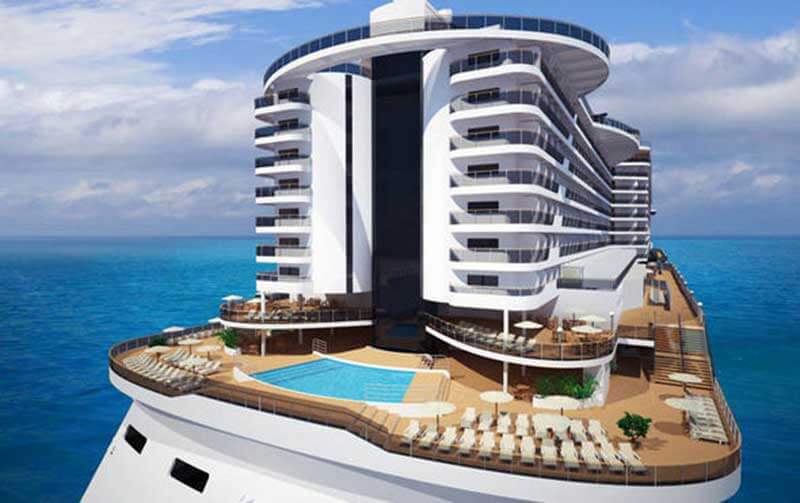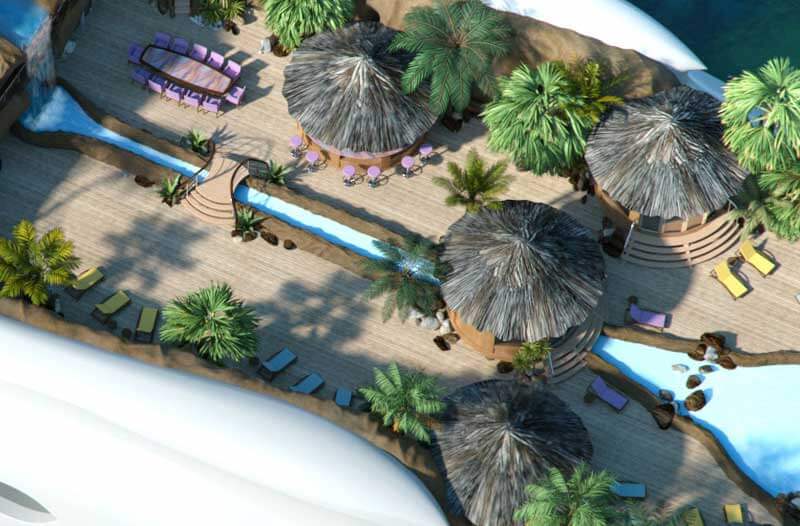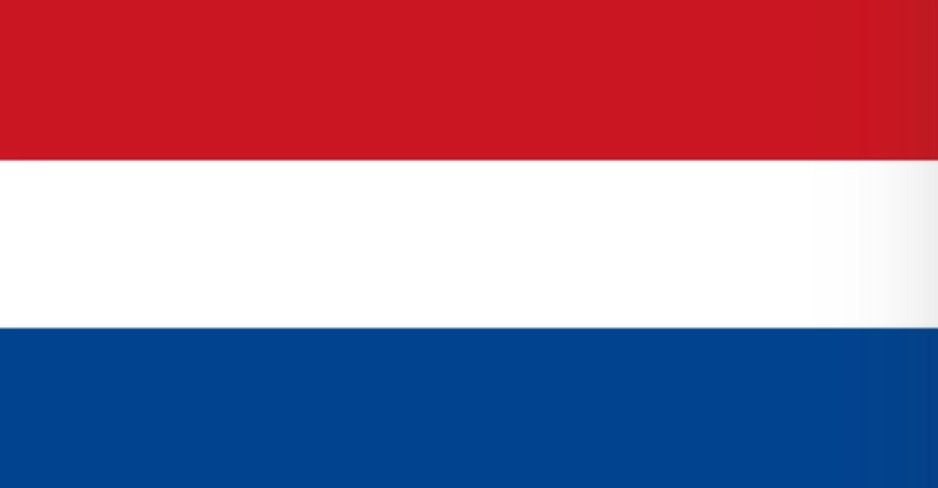- The world’s most advanced and futuristic cruise ships are soon to set sail
- The MORPHotel looks like a human spine on a cruise to nowhere
- Is it a yacht? Is it a beach resort? It is a luxury tropical island paradise
- Will these massive, high-tech lily pads save humanity?
- The battle of the boats
Who would have thought fifty years ago, that our cruise ships would have evolved into our current behemoths, capable of carrying more than 4,000 passengers? With the exponential developments in technology and design, it’s going to be interesting to see what our cruise ships will look like in 50 years’ time. In this article we will take you on a voyage to the future – from smart cruise ships with robot bartenders and concierge apps to self-sufficient floating cities that can accommodate more than 50,000 people.
MSC Cruises to launch next generation in smart cruise ships
MSC Cruises, the world’s largest family-owned cruise company is set to launch the next generation in smart cruise ships in June and December 2017. In partnership with global tech leader Samsung, the MSC Meraviglia and the MSC Seaside will be kitted out with the latest technology, ranging from high definition televisions to tablets, smartphones as well as advanced medical equipment and technology for emergency situations. These new generation smart cruise ships are revolutionary in cruise ship technology – in terms of concept, design and marine architecture.
The company’s biggest cruise ship, the MSC Meraviglia, will be sailing in the Western Mediterranean and can accommodate 4,500 passengers. The 323m long, high-tech and condo-style MSC Seaside can carry 4,140 passengers in 2,070 guest cabins, some of which boast private jacuzzis and hanging gardens. The ship offers a 360⁰ waterfront promenade as well as a glass-walled, two-deck atrium, glass walkways and panoramic exterior elevators. Another high tech element of the Seaside is a large, interactive water park with a 112-metre long waterslide where you can play a computer game and on your way down, the smart slide tracks your progress. The Seaside will be based in the Miami area from which she will cruise the Caribbean.
Both of these new smart MSC cruise ships provide advanced smart technology such as interactive photo and video walls and communication bracelets that enable passengers to remotely control various functions and facilities. Families also get tracking cards with which they can geo-locate their children. The ships also boast various eco-friendly features such as advanced water treatment systems and highly efficient solid waste management systems. The rudders, propeller and hull lines are optimised to reduce drag and fuel consumption. The ships will make use of LED lighting systems as well as advanced heat recovery systems for hot water supply to laundry facilities and swimming pools.

The world’s most advanced and futuristic cruise ships are soon to set sail
Royal Caribbean is aiming to take cruising to the next level – more advanced and more futuristic than ever before. The cruise world’s first two smart ships, Anthem of the Seas and Quantum of the seas, each have 18 decks, 2,090 state rooms and hold 4180 passengers. Aside from the standard casinos, theatres, pool decks and restaurants, these massive, floating entertainment centres now also boast various high-tech features. From wristbands that manage dining and tour reservations, onboard purchases and room access to dancing entertainment screens and robotic bartenders, these high tech ships are truly something else.
Passengers with interior rooms, for instance, no longer have to feel like they’re being kept in the dark as their virtual balconies will treat them to spectacular, real-time views of the ocean. The feeds are generated by permanently mounted cameras on the exterior of the ship. Then there’s attractions such as the ‘London Eye’ inspired glass North Star capsule, a gondola at the end of a crane arm that suspends cruise ship passengers almost a hundred metres above the deck for panoramic views – either while sailing or docked at the various exotic destinations of the cruise liners.
At the Bionic Bar, you can order your favourite cocktails via a tablet and watch them being prepared by robotic bartenders. These automated booze wizards can create two beverages per minute, using an endless array of combinations. The headless robotic bartenders look far from human and only have mechanical arms which were once used in car manufacturing. These limbs now pull down bottles from the ceiling, add mixers, shake or stir your drinks and put them on a type of conveyor belt, ready for collection. Another impressive feature on the cruise ships is the Sea-Plex entertainment centre that can actually transform itself in order to accommodate various leisure activities: from a basketball court to a rollerblading rink and even a track for bumper cars. Then there’s the skydiving simulator iFly, which makes use of wind tunnels to simulate the feeling of skydiving and the surf simulator RipCord where a layer of water is spewed up a ramp after which you can glide over the surface with a board.
The ships also boast various environmentally conscious features. The interiors offer LED and fluorescent lighting throughout and beneath the bow of the ships, air lubrication systems shoot out streams of bubbles to help the ships glide through the water on a thin layer of air. This enables minimum drag and promotes better fuel efficiency – actually reducing it by three to ten percent.
The MORPHotel looks like a human spine on a cruise to nowhere
The next, NEXT generation cruise ships will be floating, self-sustaining, solar wind or water powered platforms that have the ability to morph according to the movement of the sea on which they float. Gianluca Santosuosso, innovative London-based engineer and architect, designed this morphing ship – the MORPHotel – hoping it will change the way people look at sea travel. The MORPHotel structure looks like a spine to which various ‘capsules’ are attached. While floating, the structure adjusts to the waves and currents of the ocean. The large central vertebrae of the floatel house amenities such as theatres, gardens, pools, restaurants and spaces for solar panels and farms while the capsules primarily offer guest accommodation. In order to keep it functioning, the 800-metre long vessel features self-sustaining ecosystems that generate power from wave and solar energy. It also boasts rainwater harvesting, desalination facilities and floating vegetable gardens.
By curling its spine, the MORPHotel can create its own floating harbour and some of the more luxury units will have the ability to undock and sail within a safe distance from the boat. Via a helipad and detachable boats, guests are able to explore and enjoy the surrounding areas of the ports they dock at, leaving minimal carbon footprints. Santosuosso would like to see sea travel consume less fuel and have minimal impact. In his vision, the MORPHotel continuously floats around the world at slow speed without any real pre-determined destination or itinerary and creates a temporary extension of each host city it docks at. No plans are currently underway to actually build the MORPHotel but as increasing numbers of companies are looking to invest in developing sustainable technologies, this futuristic concept may just turn into reality sooner than we think.
Is it a yacht? Is it a beach resort? It is a luxury tropical island paradise
Designed by Derbyshire based firm Yacht Island Design – known for their outrageous, opulent yacht concepts – ‘Tropical Island Paradise’ is not quite a cruise ship and the concept has been around for a few years but it’s still worth an honorary mention. This super yacht boasts its own small floating island pads and a volcano with a waterfall that cascades into the valley pool. The extravagant multi-million dollar vessel measures 90 metres and boasts a helicopter landing pad as well as a private beach cove. Behind the beach cabanas is a communal seating area with a bar and dining area. Further elements such as mountain streams and palm trees – inspired by the tropical islands of Polynesia, the Indian Ocean and of course, the Caribbean – make this crazy yacht the perfect tropical island paradise. Inside the towering volcano, passengers can watch movies in the private cinema or withdraw into the library. There’s a gym, a games room and a fully equipped spa. Off the lavish yacht, accessible via an extendable deck down below, are various small floating islands with deck chairs and jet skis – perfect for when the millionaire owners and their guests want a change of scenery and venture out into the sea for some exciting off-ship water activities. The lavish vessel can travel at a speed of around 15 knots and accommodate up to ten guests. The price hasn’t been set yet as there are too many variables to estimate costs. But should you be in the market for one of these, expect quite a few zeroes.

Will these massive, high-tech lily pads save humanity?
Belgian architect Vincent Callebaut, known for his many award-winning, eco-friendly projects, has now designed not quite a cruise liner but a floating, self-sufficient city that can accommodate around 50,000 people. With global sea levels expected to see a significant increase within the next hundred years, many thousands of people currently living in low lying areas are likely to be displaced. The phenomenal biomimicry inspired lily pad was designed to provide shelter for these climate refugees and is envisioned to produce its own solar, wind, biomass and tidal energy. The futuristic lily pads boast marinas and mountains, surrounding an artificial lagoon which is immersed below the water line to create counterweight for the floating city. These marinas and mountains provide working, entertainment and shopping areas. Aquaculture farms and suspended gardens produce food below the surface of the water. The lily pads are intended to float around the oceans between the equator and the northern seas – wherever the Gulf Stream takes them – or close to coastal areas. The floating eco utopia project will not be happening anytime soon but future forward designs like these inspire creative, sustainable solutions to potential climate refugee problems that may result from global warming.
The battle of the boats
With cruise ships constantly jostling for the top spot, their attention grabbing attractions are growing increasingly ostentatious. The half a century old cruise ship companies are trying their hardest to keep the industry afloat and they do this by introducing the new generation of travellers to a redesigned experience – turning their ships into giant floating gadgets. Previously unthinkable features and activities are transforming cruise experiences to be almost entirely tech-driven; bartenders replaced by robots, human concierges replaced by apps and plain walls or real views from real windows replaced by interactive screens. But does integrating all this connectivity and technology really make our much needed breaks more enjoyable and relaxing? The main focus of our holidays used to be to escape technology. To unplug and recharge. As impressive as these high-tech cruise ships of the future may be, going on one of these might actually achieve the exact opposite.
Share via:



